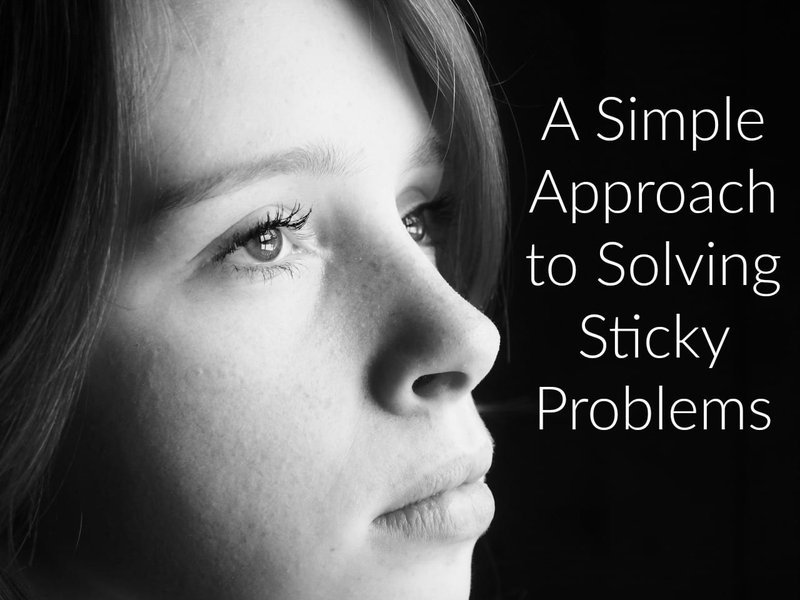A Simple Approach To Solving Sticky Problems
Stress Management

The Problem
“I have a paperwork problem.”
This was how my client Sarah, a teacher, started our most recent coaching session.
“For the most part my system works well.” She continued, “But when a student doesn’t show up for class I have to track the papers another way so they can catch up their work. Typically I have to chase them down to actually do the work. It all becomes very complicated.”
I responded, “So you have a good paper system to track the students that regularly attend and you have a good paper system to track those that miss classes. I am still not actually seeing the paperwork problem. What is too complicated?”
The Complications
Sarah thought about that for a moment. “I guess the paperwork isn’t too complicated but having to follow up with students, grade them, be responsible for their accountability, etc. is all so frustrating. I feel guilty and annoyed. It’s like I am doing too much and not enough at the same time. That’s what feels complicated.”
It sure did. It sounded really complicated. Sarah had lots of compelling thoughts and feelings swirling around. It was hard to sort through this issue and find some clarity.
When was the last time you felt like this about a particular problem? Read on for a new approach to solving problems that works great when you find yourself in a sticky, tangled web of thoughts and feelings.
“From our past conversations Sarah, we know that simplicity is a deeply held value of yours. Is there a way to simplify your thinking about this issue with your students?” I asked.
“Hmmm…well I could take a step back and realize that a lot of the feelings and thinking have to do with me and not the students. It is my thinking more than anything that is complicating things. It is ludicrous. I really just need to focus on changing my thoughts,” she concluded.
A New Approach
I decided to push Sarah a little further by asking, “And the thoughts that are complicating things – are they real?”
Sarah laughed. “No they aren’t. I don’t know why I know that but it feels true. They are all made up in my head. But when I get into the guilt and worry about doing the right thing – everything looks really real. It’s so hard to see that I am only seeing a projection of my thinking and not actually reality.“
“I’ve noticed that too.” I replied. “It seems to me that the more personal my thinking gets the further from reality I am. And my bad feelings reflect this mental state because we are only ever feeling our thinking*.”
“Can you explain that further?” she asked.
“My feelings come from my thoughts and not the other way around.” I continued. “Therefore when I don’t feel good – when I have feelings of guilt or doubt or frustration – I am confident those feelings are coming from my thoughts and not my external circumstances.”
“You are seeing this for yourself, Sarah. It looks like you feel bad because the kids aren’t doing their work and you have to chase after them. When in fact you can see that you feel bad because of your thinking about the situation – which ultimately has nothing to do with them.”
“Oh. I see,” Sarah sighed. “So the best thing for me really is to focus on changing my thinking. I have to remember to be positive and to stop thinking in such a ludicrous way. That’s what I need to do.”
Simplification
“That is definitely one approach you can take Sarah. It is where a lot of people want to put their attention: on changing their thinking. There are times this can be helpful but often this path creates more thinking – and more judgment.”
“There is however, an even simpler route to take,” I continued. “Rather than focus on changing your thinking remember that your thinking is always changing – and it is only ever made up of thought.”
“Oh!” Sarah exclaimed. “I see. My thinking is all made up anyways and it will shift on it’s own. That means I don’t have to fall so deeply into believing my thinking and taking it all so seriously.”
“Yes. Exactly.” I responded. “Our thinking is in a constant state of flux. So you really don’t need to worry about it so much because it will shift without you. And when it does you will see your situation with fresh perspective. Something new will occur to you about how to move forward.”
“As humans we forget the nature of thought and then we remember. We will always remember at some point once we’ve really seen this new direction. There is actually nothing for you to do here.”
Sarah was quiet for a moment. Allowing this new approach to sink in.
“I can’t wait to play with this,” she said.
Exactly. Will you?
Be sure to share your comments on the Facebook Page here.
*My understanding is based on the work of the late Sydney Banks, a theosopher who began sharing his understanding of the human experience – commonly referred to as the Three Principles – after an enlightened experience in the 1970’s. Click here for more information or check out my upcoming retreat that will delve much further into this material.
Latest Blog posts
![[Free Meditation] The Dangers Of Self-Improvement](/media/images/Free_Meditation_The_Da.2e16d0ba.format-jpeg.fill-590x300.jpg)
[Free Meditation] The Dangers Of Self-Improvement
How you get into the water is less important than actually being in the water.

Resources For Women With ADHD
I recently sat down with Linda Roggli, PCC, for a quick and informative interview.

10 Hard To Believe (But True) Productivity Statistics
Here are some of my favorite hard to believe productivity statistics that help point out what science has known longer than our society